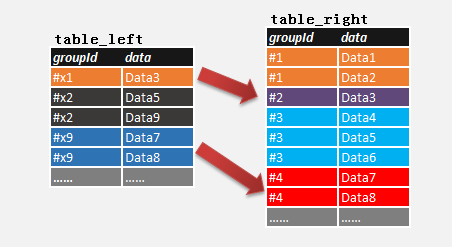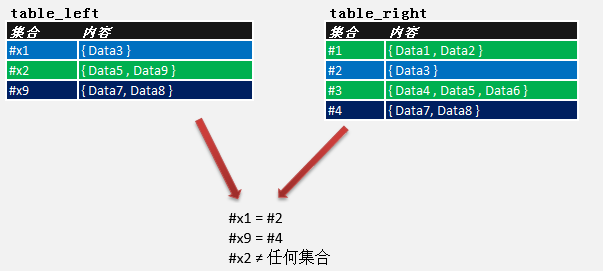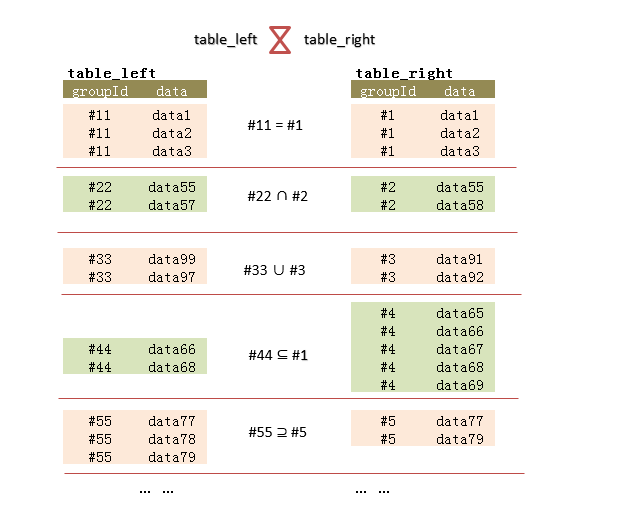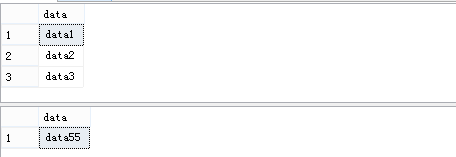開始
前一陣子,在項目中碰到這樣一個SQL查詢需求,有兩個相同結構的表(table_left & table_right),如下:

圖1.
檢查表table_left的各組(groupId),是否在表table_right中存在有一組(groupId)數據(data)與它的數據(data)完全相等.
如圖1. 可以看出表table_left和table_right存在兩組數據完整相等:

圖2.
分析
從上面的兩個表,可以知道它們存放的是一組一組的數據;那麼,接下來我借助數學集合的列舉法和運算進行分析。
先通過集合的列舉法描述兩個表的各組數據:

圖3.
這裡只有兩種情況,相等和不相等。對於不相等,可再分為部分相等、包含、和完全不相等。使用集合描述,可使用交集,子集,並集。如下面圖4.,我列舉出這幾種常見的情況:

圖4.
實現
在數據庫中,要找出表table_left和表table_right存在相同數據的組,方法很多,這裡我列出兩種常用的方法。
(下面的SQL腳本,是以圖4.的數據為基礎參考)
方法1:
通過"Select … From …Order by … xml for path('') "把各組的data列數據連串起來(如,圖4.把table_left的組#11的列data連串起來成"data1-data2-data3"),其他分組(包含表table_right)以此方法實現data列數據連串起來;然後通過比較兩表的連串後字段是否存在相等,若是相等就說明這比較多兩組數據相等,由此可以判斷出表table_left的哪組數據在表table_right存在與它數據完全相等的組。
針對方法1,需要對原表增加一個字段dataPath,用於存儲data列數據連串的結果,如:
復制代碼 代碼如下:
alter table table_left add dataPath nvarchar(200)
alter table table_right add dataPath nvarchar(200)
分組連串data列數據並update至剛新增的列dataPath,如:
復制代碼 代碼如下:
update a
set dataPath=b.dataPath
from table_left a
cross apply(select (select '-'+x.data from table_left x where x.groupId=a.groupId order by x.data for xml path('')) as dataPath)b
update a
set dataPath=b.dataPath
from table_right a
cross apply(select (select '-'+x.data from table_right x where x.groupId=a.groupId order by x.data for xml path('')) as dataPath)b
接下來就是查詢了,如:
復制代碼 代碼如下:
select distinct a.groupId
from table_left a
where exists(select 1 from table_right x where x.dataPath=a.dataPath)

完整代碼:
復制代碼 代碼如下:
View Code
use tempdb
go
if object_id('table_left') is not null drop table table_left
if object_id('table_right') is not null drop table table_right
go
create table table_left(groupId nvarchar(5),data nvarchar(10))
create table table_right(groupId nvarchar(5),data nvarchar(10))
go
alter table table_left add dataPath nvarchar(200)
alter table table_right add dataPath nvarchar(200)
go
create nonclustered index ix_left on table_left(dataPath)
create nonclustered index ix_right on table_right(dataPath)
go
set nocount on
go
insert into table_right(groupId,data)
select '#1','data1' union all
select '#1','data2' union all
select '#1','data3' union all
select '#2','data55' union all
select '#2','data55' union all
select '#3','data91' union all
select '#3','data92' union all
select '#4','data65' union all
select '#4','data66' union all
select '#4','data67' union all
select '#4','data68' union all
select '#4','data69' union all
select '#5','data77' union all
select '#5','data79'
insert into table_left(groupId,data)
select '#11','data1' union all
select '#11','data2' union all
select '#11','data3' union all
select '#22','data55' union all
select '#22','data57' union all
select '#33','data99' union all
select '#33','data99' union all
select '#44','data66' union all
select '#44','data68' union all
select '#55','data77' union all
select '#55','data78' union all
select '#55','data79'
go
update a
set dataPath=b.dataPath
from table_left a
cross apply(select (select '-'+x.data from table_left x where x.groupId=a.groupId order by x.data for xml path('')) as dataPath)b
update a
set dataPath=b.dataPath
from table_right a
cross apply(select (select '-'+x.data from table_right x where x.groupId=a.groupId order by x.data for xml path('')) as dataPath)b
--
select distinct a.groupId
from table_left a
where exists(select 1 from table_right x where x.dataPath=a.dataPath)
方法2:
通過SQL Sever提供的集運算符"Except",判斷兩組非重復的數據。如果兩組針對對方都不存在非重復的數據,就說明這兩組數據完全相等。如,表table_left中的組#11和表 table_right中的組#1,對列data進行"Except"集運算,無任是(#11 à #1)進行Except集運算,還是(#1 à #11 )進行Except集合運算,都返回空結果,這就說明組#1 和#11的data數據完全相等,如:
復制代碼 代碼如下:
select data from table_left where groupId='#11' except select data from table_right where groupId='#1'
select data from table_right where groupId='#1' except select data from table_left where groupId='#11'

同樣道理,我們把表table_left中的組#11和表 table_right中的組#2,對列data進行"Except"集運算,如:
復制代碼 代碼如下:
select data from table_left where groupId='#11' except select data from table_right where groupId='#2'
select data from table_right where groupId='#2' except select data from table_left where groupId='#11'

只要(#11 à #2 )或 (#2 à #11 )的"Except"集運算結果有記錄,就說明兩組的數據不相等。
兩張表的所有組都進行比較,我們需要通過以下SQL腳本實現,如:
復制代碼 代碼如下:
select distinct a.groupId
from table_left a
inner join table_right b on b.data=a.data
where not exists(select x.data from table_left x where x.groupId=a.groupId except select y.data from table_right y where y.groupId=b.groupId )
and not exists(select x.data from table_right x where x.groupId=b.groupId except select y.data from table_left y where y.groupId=a.groupId )

完整代碼:
復制代碼 代碼如下:
View Code
use tempdb
go
if object_id('table_left') is not null drop table table_left
if object_id('table_right') is not null drop table table_right
go
create table table_left(groupId nvarchar(5),data nvarchar(10))
create table table_right(groupId nvarchar(5),data nvarchar(10))
go
create nonclustered index ix_left on table_left(data)
create nonclustered index ix_right on table_right(data)
go
set nocount on
go
insert into table_right(groupId,data)
select '#1','data1' union all
select '#1','data2' union all
select '#1','data3' union all
select '#2','data55' union all
select '#2','data55' union all
select '#3','data91' union all
select '#3','data92' union all
select '#4','data65' union all
select '#4','data66' union all
select '#4','data67' union all
select '#4','data68' union all
select '#4','data69' union all
select '#5','data77' union all
select '#5','data79'
insert into table_left(groupId,data)
select '#11','data1' union all
select '#11','data2' union all
select '#11','data3' union all
select '#22','data55' union all
select '#22','data57' union all
select '#33','data99' union all
select '#33','data99' union all
select '#44','data66' union all
select '#44','data68' union all
select '#55','data77' union all
select '#55','data78' union all
select '#55','data79'
go
--select
select distinct a.groupId
from table_left a
inner join table_right b on b.data=a.data
where not exists(select x.data from table_left x where x.groupId=a.groupId except select y.data from table_right y where y.groupId=b.groupId )
and not exists(select x.data from table_right x where x.groupId=b.groupId except select y.data from table_left y where y.groupId=a.groupId )
方法1 Vs. 方法2 :
方法1和方法2都能找出表table_left在table_right存在數據完全相等的組#11。但性能角度上,方法2比方法1略勝一籌,可以看它們執行過程的統計信息:
方法1:

圖5.
方法2:

圖6.
如果,數據量大情況下,那麼方法2比方法1更具有明顯的優點。因為方法1,多兩個更新dataPath的部分,數據量隨著增加,這裡位置的更新就耗很多的資源;如果dataPath列數據大小超過900字節,會導致無法在dataPath創建索引,影響後面的Select查詢性能。
擴展
這裡說擴展,主要是針對上面的方法2來說。在當列data的數據大小超過900字節,或者含有多個數據列要進行比較,看是否存在兩組(groupId)的各對應列數據一一相等。

圖7.
這樣的情況,可對字段dataSub1 & dataSub2 創建一個哈希索引,如:
復制代碼 代碼如下:
alter table table_left add dataChecksum as checksum(dataSub1,dataSub2)
alter table table_right add dataChecksum as checksum(dataSub1,dataSub2)
go
create nonclustered index ix_table_left_cs on table_right(dataChecksum)
create nonclustered index table_right_cs on table_right(dataChecksum)
後面的select查詢語句,在Inner Join 部分稍改動下即可,如:
復制代碼 代碼如下:
select distinct a.groupId
from table_left a
inner join table_right b on b.dataChecksum=a.dataChecksum
and b.dataSub1=a.dataSub1
and b.dataSub2=a.dataSub2
where not exists(select x.dataSub1,x.dataSub2 from table_left x where x.groupId=a.groupId except select y.dataSub1,y.dataSub2 from table_right y where y.groupId=b.groupId )
and not exists(select x.dataSub1,x.dataSub2 from table_right x where x.groupId=b.groupId except select y.dataSub1,y.dataSub2 from table_left y where y.groupId=a.groupId )
完整代碼:
復制代碼 代碼如下:
View Code
use tempdb
go
if object_id('table_left') is not null drop table table_left
if object_id('table_right') is not null drop table table_right
go
create table table_left(groupId nvarchar(5),dataSub1 nvarchar(10),dataSub2 nvarchar(10))
create table table_right(groupId nvarchar(5),dataSub1 nvarchar(10),dataSub2 nvarchar(10))
go
alter table table_left add dataChecksum as checksum(dataSub1,dataSub2)
alter table table_right add dataChecksum as checksum(dataSub1,dataSub2)
go
create nonclustered index ix_table_left_cs on table_left(dataChecksum)
create nonclustered index table_right_cs on table_right(dataChecksum)
go
set nocount on
go
insert into table_right(groupId,dataSub1,dataSub2)
select '#1','data1','data7' union all
select '#1','data2','data8' union all
select '#1','data3','data9' union all
select '#2','data55','data4' union all
select '#2','data55','data5'
insert into table_left(groupId,dataSub1,dataSub2)
select '#11','data1','data7' union all
select '#11','data2','data8' union all
select '#11','data3','data9' union all
select '#22','data55','data0' union all
select '#22','data57','data2' union all
select '#33','data99','data4' union all
select '#33','data99','data6'
go
--select
select distinct a.groupId
from table_left a
inner join table_right b on b.dataChecksum=a.dataChecksum
and b.dataSub1=a.dataSub1
and b.dataSub2=a.dataSub2
where not exists(select x.dataSub1,x.dataSub2 from table_left x where x.groupId=a.groupId except select y.dataSub1,y.dataSub2 from table_right y where y.groupId=b.groupId )
and not exists(select x.dataSub1,x.dataSub2 from table_right x where x.groupId=b.groupId except select y.dataSub1,y.dataSub2 from table_left y where y.groupId=a.groupId )
小結
對於這個問題,可能還有其他的或更優的解決方法.而且在實際的生產環境中,可能碰到的情況會有所不同,無論如何,需要多分析,多動手多實驗,找到最優的解決方法。










